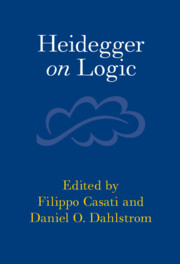Book contents
- Heidegger on Logic
- Heidegger on Logic
- Copyright page
- Contents
- Contributors
- Acknowledgments
- Method of Citation
- Introduction
- Part I Normativity, the Phenomenology of Assertions, and Productive Logic
- Part II Language, Logic, and Nonsense
- Part III Paradox, the Prospects for Ontology, and Beyond
- Part IV Logical Principles and the Question of Being
- Chapter 11 The Resonant Principle of Reason
- Chapter 12 Heidegger’s Contradictions
- References
- Index
Chapter 11 - The Resonant Principle of Reason
from Part IV - Logical Principles and the Question of Being
Published online by Cambridge University Press: 15 September 2022
- Heidegger on Logic
- Heidegger on Logic
- Copyright page
- Contents
- Contributors
- Acknowledgments
- Method of Citation
- Introduction
- Part I Normativity, the Phenomenology of Assertions, and Productive Logic
- Part II Language, Logic, and Nonsense
- Part III Paradox, the Prospects for Ontology, and Beyond
- Part IV Logical Principles and the Question of Being
- Chapter 11 The Resonant Principle of Reason
- Chapter 12 Heidegger’s Contradictions
- References
- Index
Summary
This chapter reconstructs Heidegger’s 1955–56 interpretation of the principle of reason as a principle that resonates or sounds variously in the history of philosophy. The principle is first fully formulated by Leibniz as the principle of sufficient reason, which states that there is no true fact or proposition without sufficient reason for it being so and not otherwise. Heidegger takes Leibniz’s principle of sufficient reason to be a historically specific version of the principle of reason, which is a fundamental ontological principle holding that nothing is without a reason or ground, and so that being is ground/reason. Heidegger hears this association between being and ground resonating in the ancient Greek concept of logos, which is taken up but distorted by the Romans in the concept of ratio. From there, the ontological principle develops into the principle articulated by Leibniz and comes to express the distinctive commitments of modern philosophy and technology. While Heidegger’s historical story is not entirely plausible and contains significant omissions, attempting to reconstruct it reveals why this purported history of the principle of reason is relevant to Heidegger’s broader ontological project.
Information
- Type
- Chapter
- Information
- Heidegger on Logic , pp. 221 - 239Publisher: Cambridge University PressPrint publication year: 2022
